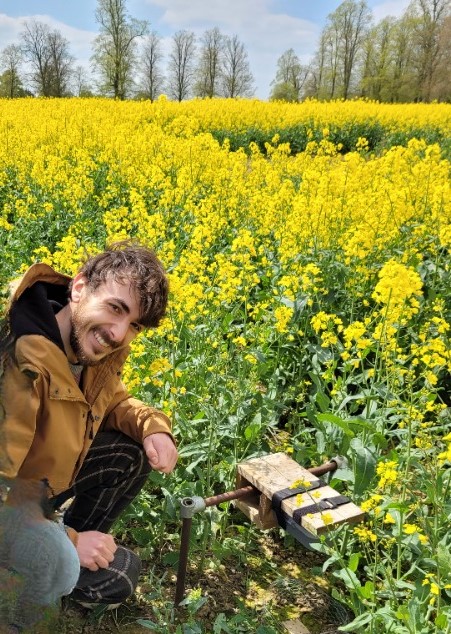The big picture: using wildflower strips for pest control
In-field cameras have uncovered unexpected predators of two major oilseed rape pests, potentially aiding control strategies. The camera study, conducted over two years in two UK locations, found that larval stages of predatory Carabid beetles play a crucial role in tackling the pollen beetle (Brassicogethes aeneus) and the brassica pod midge (Dasineura brassicae), two significant threats to oilseed rape crops.
Ecologists have long used camera traps to study wildlife, but their application in monitoring invertebrates is relatively new. Traditionally, pitfall traps have been the go-to method for studying predatory arthropods. However, the latest findings reveal that pitfall traps fail to capture large numbers of predatory beetle larvae, underestimating their impact as natural pest controllers.
Adjusting farming practices to support these natural predators may reduce the need for synthetic chemical pesticides, improving sustainability and biodiversity in agricultural landscapes
The study's key discovery is that these beetle larvae are highly effective predators, moving out of the soil where they live to actively feed on pest larvae at the precise moment they drop to the ground to pupate—when they are most vulnerable. This synchrony between predator activity and pest susceptibility could offer a new approach to pest management.

“Recognising the importance of predatory beetle larvae in natural pest control, farmers could adopt conservation biocontrol strategies that enhance the presence of these beneficial arthropods,” said Dr Sam Cook, who led the research team. “Adjusting farming practices to support these natural predators may reduce the need for synthetic chemical pesticides, improving sustainability and biodiversity in agricultural landscapes.”
The study also showed differing activity patterns depending on the time of day.
Predators of the pollen beetle larvae were significantly more active at night compared to morning or afternoon, with notable activity also recorded at dusk and dawn. This pattern was consistent across data collected in both years, indicating a preference for nocturnal activity among most predators, while some exhibited a diurnal rhythm. The highest numbers of pollen beetle larvae dropped at dusk, while the brassica pod midge larvae dropped significantly more at dawn than at other times of the day.
With European oilseed rape yields under constant threat from pests, this research provides fresh hope for more environmentally friendly farming. Encouraging predatory beetle larvae populations could be a cost-effective and ecologically sound method to keep crops safe while preserving essential predator species.
“These findings highlight the potential of cameras as powerful tools for ecological research,” said Dr Cook. “As farming continues to seek greener solutions, this innovative approach could contribute to improved pest management rooted in nature’s own defences.”
Related Rothamsted study on use of cameras in predator-prey research can be found here.

Behavioural Ecologist
Rothamsted Research is the longest-running agricultural research institute in the world. We work from gene to field with a proud history of ground-breaking
discoveries in areas as diverse as crop management, statistical interpretation and soil health. Our founders, in 1843, were the pioneers of modern
agriculture, and we are known for our imaginative science and our collaborative approach to developing innovative farm practice.
Through independent research, we make significant contributions to improving agri-food systems in the UK and internationally, with
economic impact estimated to exceed £3 bn in annual contribution to the UK economy. Our strength lies in our systems approach, which combines strategic research,
interdisciplinary teams and multiple partnerships.
Rothamsted is home to three unique National Bioscience Research Infrastructures which are open to researchers from all over the world:
The Long-Term Experiments,
Rothamsted Insect Survey and the
North Wyke Farm Platform.
We are strategically funded by the Biotechnology and Biological Sciences Research Council (BBSRC), with additional support from other national and
international funding streams, and from industry. We are also supported by the Lawes Agricultural Trust (LAT).
The Biotechnology and Biological Sciences Research Council is part of UK Research and Innovation, a non-departmental public body funded by a grant-in-aid
from the UK government.
BBSRC invests to push back the frontiers of biology and deliver a healthy, prosperous and sustainable future. Through our investments, we build and support a vibrant,
dynamic and inclusive community which delivers ground-breaking discoveries and develops bio-based solutions that contribute to tackling global challenges,
such as sustainable food production, climate change, and healthy ageing.
As part of UK Research and Innovation (UKRI), we not only play a pivotal role in fostering connections that enable the UK’s world-class research and innovation system
to flourish – we also have a responsibility to enable the creation of a research culture that is diverse, resilient, and engaged.
BBSRC proudly forges interdisciplinary collaborations where excellent bioscience has a fundamental role. We pioneer approaches that enhance the equality, diversity,
and inclusion of talent by investing in people, infrastructure, technologies, and partnerships on a global scale.
The Lawes Agricultural Trust, established in 1889 by Sir John Bennet Lawes, supports Rothamsted Research’s national and international agricultural science through the provision of land, facilities and funding. LAT, a charitable trust, owns the estates at Harpenden and Broom's Barn, including many of the buildings used by Rothamsted Research. LAT provides an annual research grant to the Director, accommodation for nearly 200 people, and support for fellowships for young scientists from developing countries. LAT also makes capital grants to help modernise facilities at Rothamsted, or invests in new buildings.